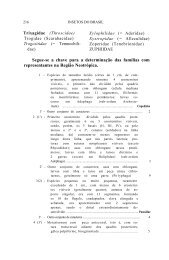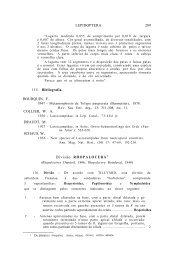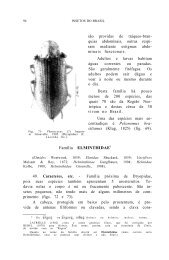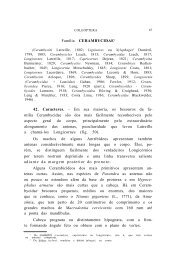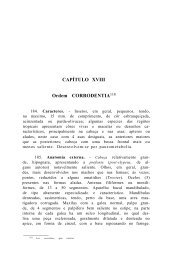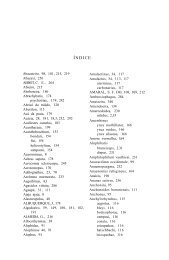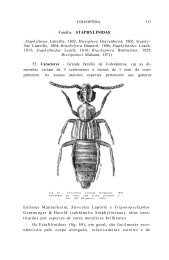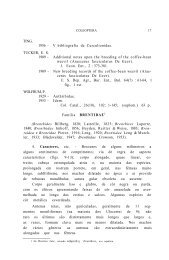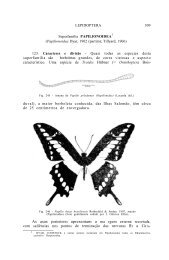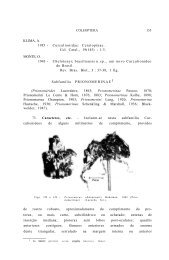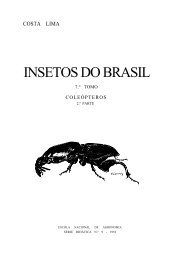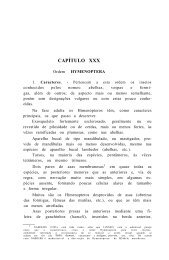SuperfamÃlia ICHNEUMONOIDEA - Acervo Digital de Obras Especiais
SuperfamÃlia ICHNEUMONOIDEA - Acervo Digital de Obras Especiais
SuperfamÃlia ICHNEUMONOIDEA - Acervo Digital de Obras Especiais
You also want an ePaper? Increase the reach of your titles
YUMPU automatically turns print PDFs into web optimized ePapers that Google loves.
60 INSETOS DO BRASIL<br />
THOMPSON, W. R. & H. L. PARKER<br />
1930 - The morphology and biology of Eulimneria crassifemur<br />
an important parasite of the European corn borer.<br />
J. Agric. Res., 40:321-345, 7 figs.<br />
TIMBERLAKE, P. H.<br />
1912 - Technical results from the Gypsy Moth Parasit Laboratory.<br />
V - Experimental parasitism, a study of the biology<br />
of Iimnerium validum (Cresson).<br />
U.S. Dep. Agr., Ent., Techn. Ser., 19(5):71-92, figs.<br />
TOWNES, H. K.<br />
1938 - The Neartic species of Netelia (Paniscus of authors) and<br />
a revision of the genera of Netelini (Hymenoptera,<br />
Ichneumonidae).<br />
Lloydia, 1:168-231, 8 ests.<br />
TOWNES, H. K. & MARJORIE<br />
1951 - A revision of the genera and of the Neartic species of<br />
Grypocentrini (Hymenoptera, Ichneumonidae).<br />
Proc. Ent. Soc. Wash., 53:301-313, 6 figs.<br />
VIERECK, H. L.<br />
1925 - A preliminary revision of the Campopleginae in the Canadian<br />
National Collection, Ottawa.<br />
Canad. Ent., 57:176-181; 198-204; 223-228; 296-303.<br />
Subfamília TRYPHONINAE<br />
(Tryphoninae Cresson, 1887; Tryphonidae Thomson; Tryphoninae<br />
Ashmead, 1895; 1900; Ceballos, 1956.<br />
20. Caracteres, etc. - Grupo <strong>de</strong> Ichneumoni<strong>de</strong>os cujas<br />
espécies, especialmente os machos, via <strong>de</strong> regra, se distinguem<br />
das <strong>de</strong> outras famílias apenas por caracteres negativos.<br />
O 1.° urômero, geralmente sessil, é feto ou pouco incurvado,<br />
raramente peciolado, com os espiráculos na meta<strong>de</strong><br />
banal. Ovipositor muito curto ou escondido.<br />
Os Trifonineos parasitam principalmente larvas <strong>de</strong> Tenthredini<strong>de</strong>os<br />
e <strong>de</strong> Dipteros. As espécies do gênero Sphecophaga<br />
Westwood parasitam Polistes e Vespula (ninhos).<br />
Não obstante tratar-se <strong>de</strong> grupo constituído por mais <strong>de</strong><br />
2.000 espécies, bem poucas são as conhecidas na América do<br />
Sul quanto ao modo <strong>de</strong> vida.




